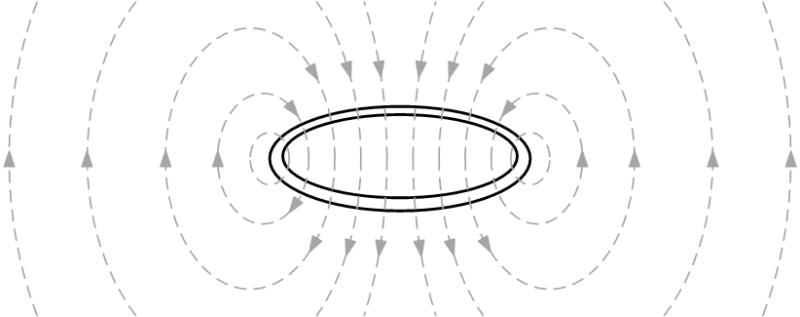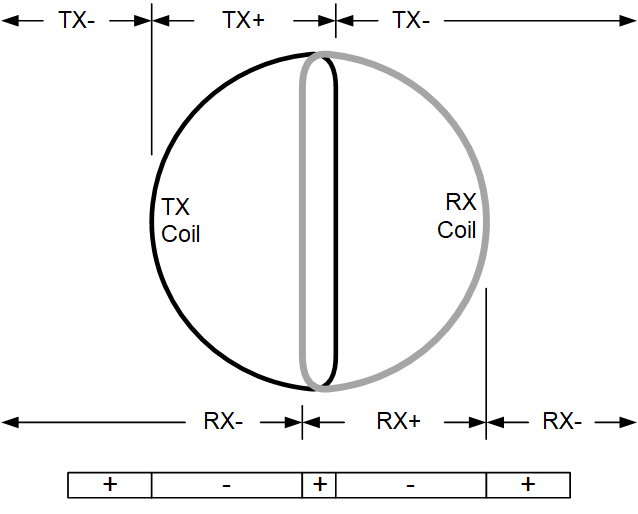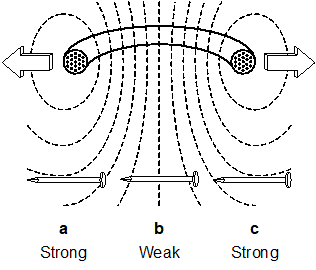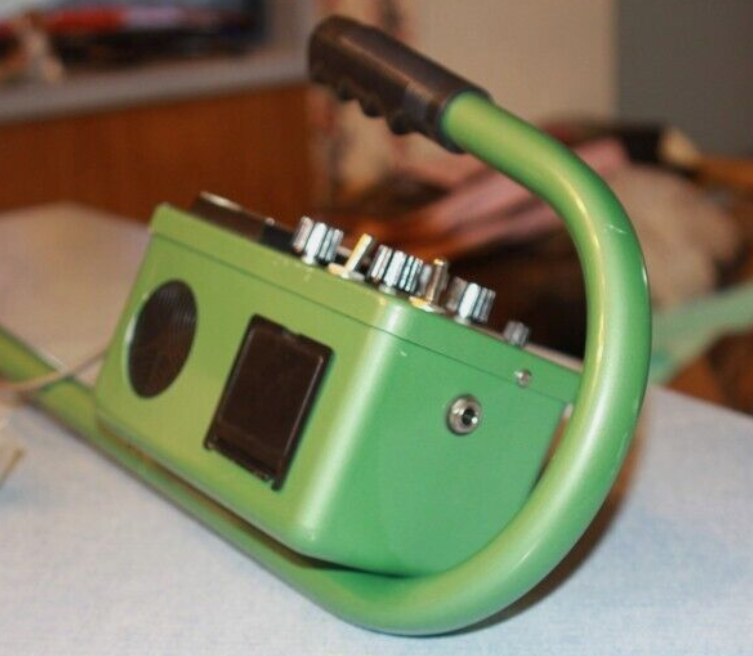-
Posts
576 -
Joined
-
Last visited
-
Days Won
5
Content Type
Forums
Detector Prospector Home
Detector Database
Downloads
Everything posted by Geotech
-
Keep in mind that if you buy a Q80 in Canada and then take it into the US you will be personally infringing the ML patent and legally exposed. I can't imagine that ML would go after an individual but you never know. Loose lips enable lawyers to buy expensive ships.
-

The Nail Board Test And Sensitivity
Geotech replied to NCtoad's topic in Metal Detector Advice & Comparisons
Magnetic fields form enclosed loops of flux; here is what it looks like for a coil: The flux has direction which is equivalent to polarity; let's call the downward flux through the center to be "positive" and the returning flux around the outside to be "negative." This is obviously the case for a TX coil but the field received by the RX coil has the same polarity: flux running through the center of the RX coil is positive and flux that runs to the outside of the coil is negative. Now put the TX & RX coils together in a DD coil and mark these regions: Basic math: (+) x (+) = (+) (+) x (-) = (-) (-) x (-) = (+) So the overlap region with +TX and +RX will produce a positive signal, but so will targets outside the perimeter of the coil although they will be weak. The areas inside one coil but outside the other produce negative signals that the detector ignores. -
I used to have several Compass detectors. The first thing people lost was the battery cover.
-

The Nail Board Test And Sensitivity
Geotech replied to NCtoad's topic in Metal Detector Advice & Comparisons
Yes, that's what I mean by longitudinal. A nail creates a double beep because it has a maximum return signal when the coil's magnetic field aligns with it. Here is an illustration The arrows show the direction of the coil sweep. The magnetic field bends outward and the nail will have a maximum response at points (a) & (c), while minimum at (b). A coin is the opposite; it will have a maximum response at (b). So imagine a nail at (a) and a coin at (b); as the coil sweeps over they will both have a maximum response at the same point in the sweep. This is independent of recovery speed, it's just geometry. -
'839 is narrowly defined to cover sine-weighted demod clocks. You can avoid the patent by using square-wave demod clocks, which is likely what Garrett & XP did. I live 20 miles from Canada, unfortunately no detector dealers in Grand Forks. I had planned a drive up to Jasper in a couple of weeks but the Kelowna wildfire has caused travel restrictions. The use of sine-weighted demodulation dates back at least 100 years in tube radios, and at least the 1980s in software radio architectures. '839 is one of those patents that should never have been issued, as it's a commonly-known technique simply applied to a metal detector, which is otherwise just like any other quadrature demodulation application (like your cell phone). There was no actual invention here.
-
-
"toddm32" would be Todd Marshall, who runs the Centerville-West White's repair facility.
-
For a color LCD, the backlight usually degrades/fails before the actual screen. The V3 uses a transflective LCD so it can run without a backlight, and doing so will extend its life. But even the screen itself can degrade, and excessive heat will speed that up. So ignoring the backlight, age is more of a factor.
-

White’s TDI Battery Modifications
Geotech replied to BeachBunnyTRHunter - DP's topic in White's Metal Detectors
Soldering tips: Before removal, apply a liberal amount of lead-based solder to each pad. The lead-free stuff that's on the board is hard to reflow and adding a big mass of lead solder helps tremendously. On the FET, bend/lift the individual pins off their pads before attacking the body. On the resistors, crack the resistor body and then you can remove the halves easily. A desoldering heat gun is the proper method. As cheap as $15. -

Whites TDI SL 5 Battery 20 Volt Pack. What Have I Done...?
Geotech replied to CaliGold's topic in White's Metal Detectors
Yes, 2-3W on the resistors and at least a heat sink on Q4. -

Whites TDI SL 5 Battery 20 Volt Pack. What Have I Done...?
Geotech replied to CaliGold's topic in White's Metal Detectors
3 components are subject to overheating: Q4, R9, and R14. R9 should be 1000Ω and R14 = 680Ω, I think they are both 1W. Most likely Q4 has been partially damaged, enough to alter performance but not enough to kill it. When jacking up the battery voltage these 3 components really should be upgraded for add'l power handling. -
Yeah, that looks like a faulty display. It's good to know there might be a direct replacement. When Sharp obsoleted that display we looked for a replacement but there was none at the time.
-
The best I can do is a schematic for the RB5, which was the middle sister in the RB family (RB7/RB5/RB3). It should be very close to the RB7 circuit as there were only minor differences in the machines. With only a quick look, I'd say the burned transistor is Q115 which regulates the +8V supply. You can replace it, but there may be another problem downstream that caused it to burn. And, yes, it uses 2x12V AA battery packs, easily found online. BH_RB5.pdf
-
Trying to sub a color display is tricky. Did you compare the data sheets to make sure the flex tail pinouts were the same, and that the timing was the same? The fact that the sub works at all suggests they are very close, but the black bars may be due to a timing difference.
-
Sorry, I missed "with the coil off." Yup, 25mA is bigly wrong. Sounds like it's not powering down. Could be software, I'd start with a reprogram. But there also might be a controller MOSFET that's gotten shorted.
-

Polish Pi Metal Detector
Geotech replied to Joel - cacadordereliquia's topic in Metal Detector Advice & Comparisons
The values look reasonable to me. T3 might have the collector-emitter swapped, that's the only thing I spotted. -
25mA sounds reasonable. What does "discharges completely" mean? Is that when it stops running? If so, 32 hrs also sounds pretty good, but I don't know what is normal.
-

Polish Pi Metal Detector
Geotech replied to Joel - cacadordereliquia's topic in Metal Detector Advice & Comparisons
It's a very basic PI detector, meant as a simple do-it-yourself construction project. It's on the level of the Surfmaster PI or Sandshark, and no where even close to a Minelab PI. It has no ground balance so would be a poor choice for prospecting. -

Amazed At How Quickly White’s Discussion Faded
Geotech replied to Steve Herschbach's topic in White's Metal Detectors
The MX-series is still one of my favorite, I have an MXT, MX9, and MX-Sport. Except for salt water, they are still competitive detectors. I never liked the T2/F75 (again, same design) because of the single-button interface, which I found to be awful. The F70 is a much better experience. -

Amazed At How Quickly White’s Discussion Faded
Geotech replied to Steve Herschbach's topic in White's Metal Detectors
Guys, the MXT is no more analog than the MX-Sport. They are the same basic design: analog demodulators, everything else is digital. The MXT used an 8-bit PIC micro and assembly language. The MX5 moved it to a 32-bit micro and "C" language, and cleaned up the analog portion a bit. Otherwise, same design. The MX-Sport is the same design as the MX5, with feature changes. The T2 is also the same design as the MXT, with feature changes. None of them are any more analog, or more digital, than the others. Tidbit: When the MX5 was released, there were also MX7 and MX9 models ready to go, with progressively more features. White's did not want to release them, because they didn't want them to impact the sales of the MXT. No, I don't understand that logic, either. Years later, a different MX7 was released. I still have an MX9 prototype, the only one in existence. -

Whites Electronics History Question
Geotech replied to Cascade Steven's topic in White's Metal Detectors
I know a lot of the history but it would take a long time to write it up. Good references are catalogs and the White's "Discovery" magazines; I have complete collections of both. Most of the catalogs are also available at https://treasurelinx.geotech1.com/Whites/Whites.html. There was a woman named "Patty" who worked at White's who knew every detector model and every date off the top of her head. She ran the literature dept; she had 6 filing cabinets full of historical info and photos, I'll bet every bit of that went to the landfill. -

Amazed At How Quickly White’s Discussion Faded
Geotech replied to Steve Herschbach's topic in White's Metal Detectors
Jim, I guess you could say it was price, as the owners considered the company worth way more than it actually was. In the end, the owners (& dependents) didn't want to give up the cash cow. Joe, I'll not rehash old history, other than to say in all my 50 years of work experience, the 6 years at White's has been my favorite. I wish things had turned out differently. I have no idea why Garrett bought White's, but I suspect we've seen the last of White's tech from Garrett. -

Frequency Tester I Tossed Together
Geotech replied to kac's topic in Metal Detector Advice & Comparisons
What is the battery for? Are you using this to measure TX waveform signals? -

Amazed At How Quickly White’s Discussion Faded
Geotech replied to Steve Herschbach's topic in White's Metal Detectors
When I was there, an employee buy-out was proposed but the owners had no interest.









